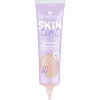What's inside
What's inside
 Key Ingredients
Key Ingredients

 Benefits
Benefits

 Concerns
Concerns

 Ingredients Side-by-side
Ingredients Side-by-side

Hydrogenated Polyisobutene
EmollientEthylhexyl Palmitate
EmollientPhenyl Trimethicone
Skin ConditioningTridecyl Trimellitate
EmollientDiisostearyl Malate
EmollientSimmondsia Chinensis Seed Oil
EmollientSqualane
EmollientSilica Dimethyl Silylate
EmollientEthylene/Propylene/Styrene Copolymer
Isododecane
EmollientLinum Usitatissimum Seed Oil
PerfumingPassiflora Edulis Seed Oil
EmollientSalvia Hispanica Seed Oil
MoisturisingTocopheryl Acetate
AntioxidantHydrolyzed Sodium Hyaluronate
Skin ConditioningLimnanthes Alba Seed Oil
Skin ConditioningCurcuma Longa Root Oil
PerfumingCurcumin
AntioxidantZingiber Officinale Root Extract
MaskingBentonite
AbsorbentGlyceryl Behenate
EmollientAlcohol
AntimicrobialParfum
MaskingTitanium Dioxide
Cosmetic ColorantIron Oxides
CI 19140
Cosmetic ColorantHydrogenated Polyisobutene, Ethylhexyl Palmitate, Phenyl Trimethicone, Tridecyl Trimellitate, Diisostearyl Malate, Simmondsia Chinensis Seed Oil, Squalane, Silica Dimethyl Silylate, Ethylene/Propylene/Styrene Copolymer, Isododecane, Linum Usitatissimum Seed Oil, Passiflora Edulis Seed Oil, Salvia Hispanica Seed Oil, Tocopheryl Acetate, Hydrolyzed Sodium Hyaluronate, Limnanthes Alba Seed Oil, Curcuma Longa Root Oil, Curcumin, Zingiber Officinale Root Extract, Bentonite, Glyceryl Behenate, Alcohol, Parfum, Titanium Dioxide, Iron Oxides, CI 19140
Water
Skin ConditioningTitanium Dioxide
Cosmetic ColorantTributyl Citrate
SolventButylene Glycol
HumectantDicaprylyl Ether
EmollientEthylhexyl Triazone
UV AbsorberMyristyl Lactate
EmollientC13-15 Alkane
SolventSilica
AbrasiveDiethylamino Hydroxybenzoyl Hexyl Benzoate
UV FilterBis-Ethylhexyloxyphenol Methoxyphenyl Triazine
Skin ConditioningPolyglyceryl-6 Polyricinoleate
EmulsifyingPolyglyceryl-6 Polyhydroxystearate
EmulsifyingTalc
AbrasiveMagnesium Sulfate
Dimethicone/Vinyl Dimethicone Crosspolymer
Skin ConditioningAloe Barbadensis Leaf Juice Powder
Skin ConditioningSodium Hyaluronate
HumectantTocopherol
AntioxidantCetyl Alcohol
EmollientDextrin Palmitate
EmulsifyingPolyglycerin-6
HumectantXanthan Gum
EmulsifyingTriethoxycaprylylsilane
Phenoxyethanol
PreservativeCI 77491
Cosmetic ColorantCI 77492
Cosmetic ColorantCI 77499
Cosmetic ColorantWater, Titanium Dioxide, Tributyl Citrate, Butylene Glycol, Dicaprylyl Ether, Ethylhexyl Triazone, Myristyl Lactate, C13-15 Alkane, Silica, Diethylamino Hydroxybenzoyl Hexyl Benzoate, Bis-Ethylhexyloxyphenol Methoxyphenyl Triazine, Polyglyceryl-6 Polyricinoleate, Polyglyceryl-6 Polyhydroxystearate, Talc, Magnesium Sulfate, Dimethicone/Vinyl Dimethicone Crosspolymer, Aloe Barbadensis Leaf Juice Powder, Sodium Hyaluronate, Tocopherol, Cetyl Alcohol, Dextrin Palmitate, Polyglycerin-6, Xanthan Gum, Triethoxycaprylylsilane, Phenoxyethanol, CI 77491, CI 77492, CI 77499
Alternatives
Ingredients Explained
These ingredients are found in both products.
Ingredients higher up in an ingredient list are typically present in a larger amount.
Titanium dioxide is a mineral UV filter widely used in sunscreens and cosmetics.
It is one of only two UV filters officially classified as “mineral” by regulatory agencies, the other being zinc oxide.
Titanium dioxide provides broad-spectrum protection mostly in the UVB and UVAII range, with some protection in the UVAI range.
While its UVA protection isn’t as strong as zinc oxide’s, the difference is minor.
A common myth is that mineral UV filters reflect UV light. However, modern research shows titanium dioxide absorbs UV radiation like chemical filters (~95% absorption & 5% reflection).
Thanks to its non-irritating nature, titanium dioxide is suitable for sensitive, acne-prone, or redness-prone skin. It is unlikely to cause "eye sting" like other sunscreen ingredients.
A major drawback of this ingredient is its white cast and thick texture. This is why mineral sunscreens often leave a white cast and are less cosmetically elegant than chemical/hybrid sunscreens.
To improve white cast and spreadability, micronized or nano-sized titanium dioxide is often used.
There are ongoing concerns surrounding nano-titanium oxide's impact on marine ecosystems.
There is no conclusive evidence that any form of titanium oxide (or any other sunscreen ingredients) will cause harm to marine ecosystems or coral reefs. The science is still developing but many consumers are keeping a close eye on this issue.
Please note, many destinations have reef-safety sunscreen rules. For instance, the U.S. Virgin Islands advises all visitors to use non-nano mineral sunscreens.
Nano mineral sunscreens once raised safety concerns about absorption into skin.
Extensive research has shown that they do not penetrate healthy or damaged skin; they remain safely on the surface and the top layer of dead skin (stratum corneum).
You'll likely find titanium dioxide bundled with alumina, silica, or dimethicone. These ingredients help make titanium dioxide highly photostable; this prevents it from interacting with other formula components under UV light.
Learn more about Titanium Dioxide